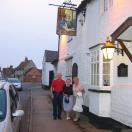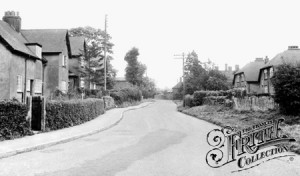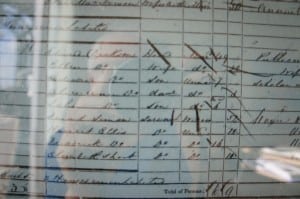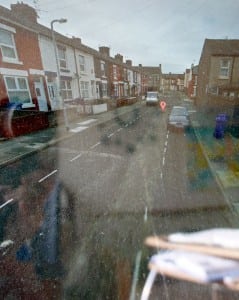Like a Dickens Novel: The Goode Life 1809-1901.
Like a Dickens novel: The Goode Family Timeline 1809-1901
Escape from agrarian poverty…Master of workhouses in London’s East End and Liverpool…a child’s death…pubs, hotels and a rise to wealth and prominence…then tragedy…and a return to impoverishment. It is a true Victorian tale. Like all research on this website, this is a work in progress.
Richard White 1809 –
Great-great-grandfather of Eileen, Peggy, Nancy and Thelma
1809: Birth, Hungry Harbury, Warwickshire. Now just part of Harbury, 15 miles north of Stratford on Avon, hence the Shakespeare Inn pictured here.
1841: Census: Wolfhampcote, Warwickshire (11 miles from Hungry Harbury). Household: Richard White, 30, agricultural labourer; Lucy White, 25; Thomas Goode, 4.
1871: Census: Wolfhamcote, Flecknoe, Warwickshire, near Royal Oak. Household: Richard White, Head, 62, Tailor, b Hungry Harbury; Lucy White, Wife, 56, b Flecknoe. Over 30 years, Richard White has risen from agricultural labourer to a tailor.
________________________________________________________________
Lucy White 1815 –
Great-great-grandmother of Eileen, Peggy, Nancy and Thelma
1815: Born, Flecknoe, Warwickshire.
1841: Census: Wolfhampcote. Household: Richard White, 30, agricultural labourer; Lucy White, 25; Thomas Goode, 4.
1871: Census: Wolfhamcote, Flecknoe, Warwickshire, near Royal Oak. Household: Richard White, Head, 62, Tailor, b Hungry Harbury; Lucy White, Wife, 56, b Flecknoe.
1881: Census: Wolfhamcote, Warwickshire. Household for No 36 (illegible) is: Lucy White, 65, Head, b Flecknoe, Warwickshire; Alice Ann Goode, 10, granddaughter (of Lucy White), scholar, b Walton, Liverpool. She will go on to be the mother of May Minchin.
________________________________________________________________
Thomas Goode 1838-
Grandfather of May Wood; Great Grandfather of Eileen, Peggy, Nancy and Thelma
1838: Birth, Wolfhamcote, Warwickshire. It is one year after the accession of Queen Victoria to the throne, and Thomas Goode’s life will run in parallel to her reign and reflect its remarkable social changes.
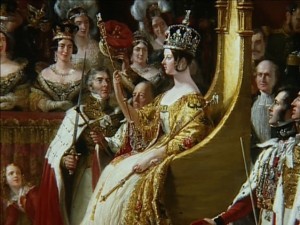
Queen Victoria’s Coronation. The Saga of the Goode family runs parallel with the Queen’s long reign mirroring the extraordinary social advances – and hazards – of the Victorian era as millions try to escape grinding poverty.
1841: Census: Wolfhampcote. Household: Richard White, 30, agricultural labourer; Lucy White, 25; Thomas Goode, 4. This is the first national census and it doesn’t say Thomas is their son. If he is, why is his surname different? Was he an orphan – son of Thomas Saunders, clergyman. See Marriage below.
1861: Census: St Leonard’s Workhouse, Shoreditch, in London’s East End. Thomas Goode, Unmarried, 24, Superintendent of Workhouse, b Wolfhampcote, Warwickshire. For details of workhouse go to: http://www.workhouses.org.uk/Shoreditch/
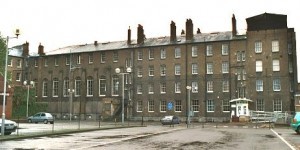
‘A frightful accumulation of human failures’ – Thomas Goode was Superintendent at the St Leonard’s Workhouse, Shoreditch.
Conditions had not much improved since Charles Dicken’s wrote about such workhouses in Oliver Twist in 1838. Oliver preferred the streets to the institution.
A report in The Lancet in 1865 is highly critical of St Leonard’s. Thomas Goode as Superintendent – second in charge – would have to take a share of responsibility although he was only 24. One part of the report says: ‘…The general aspect of the wards is one of extreme cheerlessness and desolation. This is painful throughout; but it is especially lamentable in the case of the lunatics and imbeciles. Moping about in herds, without any occupation whatever; neither classified, nor amused, nor employed; congregated in a miserable day-room, where they sit and stare at each other or at the bare walls, and where the monotony is only broken by the occasional excitement due to an epileptic or the gibbering and fitful laughter of some more excitable lunatic, they pass a life uncheered by any of the brightening influences which in well-managed asylums are employed to develop the remnants of intelligence and to preserve them from total degradation.
‘They have here neither fresh air nor exercise, no outdoor or indoor occupation of any kind. The exercise-ground is a wretched yard with bare walls, confined in space, and utterly miserable and unfit for its purposes. It is a frightful accumulation of human failures, treated with utter neglect of their human character; kept in tolerably clean rooms, and fed with sufficient food, as we would kennel dogs in decent kennels…
‘…To make matters as bad as possible, the nurses, with one exception, are pauper nurses, having improved rations and different dress, but no pecuniary encouragements. They are mostly a very inferior set of women; and the males, who are “nursed” by male paupers, are yet worse off. The nursing organization at this establishment is as bad as can be. The male nurses especially struck us as a peculiarly rough, ignorant, and uncouth set.’
When the report was published Thomas Goode had probably left Shoreditch but the comments do not reflect well on him.
1861-5: Thomas Goode leaves London and becomes Master of a huge new Workhouse, at Everton, West Derby, Liverpool.

Walton Workhouse. Built in 1864 to house 1,000 inmates. Thomas Goode became the first Master and his wife Alice Ann was appointed Matron although still in her teens.
One report says: ‘The new workhouse at Walton, the first stone of which was laid on the 29th of March, 1864, by Mr. Thomas Haigh (the then chairman of the West Derby Board of Guardians), has been formally opened. The edifice has been constructed to accommodate 1,000 inmates, and has cost, including the price of the land (purchased from Lord Sefton), £65,000. The grounds extend over an area of 37 acres, and it is intended to devote a great portion of the land to cultivation, so as to afford useful employment for the inmates. At either end of the building are hospitals for male and female inmates, and it is intended immediately to proceed with the laying out of a cemetery and the erection of a church. The main building is already nearly full; and it is probable that in course of time the accommodation will not be too much for the numerous poor chargeable to the rates of the West Derby Union.’
Thomas Goode meets Alice Ann Dickson, who is in her teens and the daughter of a Liverpool publican.
1865: Marriage, 20 January, to Alice Ann Dickson, age 18, b 1847. On the certificate Thomas Goode is described as Governor of the Workhouse, Everton, West Derby. His father is given as Thomas Saunders, Clergyman. Her father is Edward Dickson, Gentleman. Witnesses Edward Dickson and Agnes Linsey ? Ogilvie. In fact Census of 1851 and 1861 describe Edward Dickson as a ‘Publican’ – which is several rungs lower than Gentleman. But it showed aspiration.
Alice becomes “Matron” of the Workhouse.
1868: Father to son Albert Edward Goode.
1871: Census: West Derby Union Workhouse, Walton, Liverpool. ‘Return of all the persons who slept of abode in this institution on the night of Sunday April 2nd, 1871.’ Thomas Goode, Head of family, 33, Workhouse Master, b Wolfhamcote, Warwick; Alice Ann Goode, Wife, 24, Workhouse Matron, b Liverpool; Albert Edward Goode, Son, 3, b Walton on the Hill. Then follows a list of Workhouse staff – clerks, assistants, two school teachers, a cleaner, a book keeper, midwife, laundress, washerwomen and others.
1871: Father to daughter Alice Ann Goode. Baptism record from parish church of St Peter, Liverpool: Alice Ann Goode born 28 April. Baptised 18 May, daughter of Thomas and Alice Ann Goode. He is described as Master of the Workhouse, Walton on the Hill.
1871: Death of son Albert Edward, age 4, West Derby. Is this one of the reasons the family later left the Workhouse where infectious diseases were endemic? The whole family, especially the children, must have been at constant risk both in the institution and that part of poverty-stricken Liverpool.
1873: Father to son George A. Goode. Note: Thomas Goode still listed as ‘Master of the Workhouse, Walton’ at George’s baptism, 31 December.
1874: Father to Ada Florence Goode, also born at West Derby (West Derby is in the title of the Workhouse).
Then comes the 1881 Census, showing the change in circumstances. If accurate, the family moves from the workhouse to a pub. All family names and ages match precisely. Working in a Workhouse, even as the Master, must have been a demanding, even unpleasant job, especially after the death of their son Albert Edward in 1871. They would have been afraid of losing their three remaining small children, Alice, George and Ada.
Surrounded by poverty, misery and the dying, they probably wanted to escape to a more pleasant and healthy life, one on a more human scale and better suited to raising a family. At this time Alice Ann Goode, Thomas’s wife, was still only around age 30. A lifetime as Workhouse Matron – a grim task in the best circumstances – could not have been an inspiring prospect to a young mother.
In research terms, the problem is the Marriage Certificate 1865 in which Thomas Goode gives his father as ‘Thomas Saunders, Clergyman’. Have found no trace of such a cleric. But this still does not explain why he is called ‘Goode’, anymore than the 1841 Census does when he is part of the ‘White’ household. All the other facts match, especially the two younger children George A. and Ada F. At George’s Baptism 1873, Thomas calls himself ‘Master of the Workhouse’. Then, in 1891 Census, Ada F. Goode is found to be living in Cheltenham with her sister Alice Ann who is shortly to give birth to a daughter May (May Minchin to be).
Also Thomas makes the switch to being a publican probably having taken advice from his father in law Edward Dickson, who had run two pubs, first in Castle Street, then in Cairo Street, both in Everton, Liverpool.
1881: Census: Kings Arms, 8 Moor Street, Ormskirk, Lancashire. Household: Thomas Goode, Head, 43, Hotel Keeper, born Wolfhamcote, Warwickshire; Alice A, 33, wife of Hotel Keeper, born Liverpool; George A, son, 8, scholar, born Walton on the Hill; Ada F, daughter, 6, scholar, born Walton on the Hill; James A Byrnes, servant, 18, billiard marker; Alice Winrow, 17, General Serv, Domestic; Mary Corfield, 20, General Servant; Ellen Mayer, 26, Servant/Barmaid.
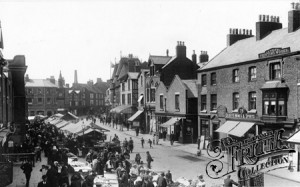
Moor Street, Ormskirk. It must have seemed like a breath of fresh air after the grimness of Walton Workhouse.
But where is the eldest child, Alice Ann (future mother of May Minchin)? That mystery is also solved in the 1881 census.
1881: Census: Alice Ann is living with grandmother in Wolfhamcote, Warwickshire, the village where her father Thomas Goode was born. The household for No 36 (illegible) is: Lucy White, 65, Head, b Flecknoe, Warwickshire; Alice Ann Goode, 10, granddaughter (of Lucy White), scholar, b Walton, Liverpool. But despite the Census, a doubt remains over whether Alice Ann is the biological granddaughter because a) surname differs b) Thomas Goode’s claim that his father was a cleric called Thomas Saunders.
1881: Census. By this time the Master of Walton Workhouse is named as William Henry Bucknell, with his wife Emily at matron, confiming that Thomas Goode had left the post.
1881-89:Thomas Goode’s wife Alice Ann dies (to be confirmed). Thomas moves to Cheltenham, along with daughters Alice Ann and Ada Florence.
Thomas meets Frances Turner, b 1842 Leicester,, who has one son Edward. They marry.
Alice Ann meets Edward Wood, a pawnbroker with a shop at 199 High Street, Cheltenham.
1889: Alice Ann Goode marries Edward Wood, Cheltenham.
1891: Census: Sherbourne Arms, 33 Sherbourne St, Cheltenham. Household: Thomas Goode, Head, 54, Licensed Victualler, b Wolfhampcote, Warwick; Frances A Goode, Wife, 49, b Leicester; Edward H Turner, Stepson (to Thomas Goode), Storekeeper/Clerk, 17; Annie Godsell, Domestic Servant, 17.
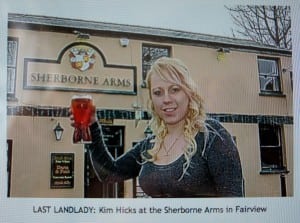
“Plans to raze a historic Cheltenham pub to the ground and replace it with homes have been turned down…The decision came after stinging criticism of the tactics used by large pub companies in deliberately ‘running down’ venues before putting them forward for housing. Kim Hicks, 21, the last landlady (pictured), claimed she was never given a proper chance to turn the venue’s fortunes around – Goucestershire Echo, Jan 12, 2012.
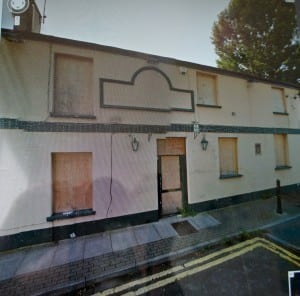
This is where Thomas Goode and his second wife Frances lived, probably with their daughters Alice and Ada to begin with. More than a century later, in 2013, the Sherborne Arms is boarded up and unused. Its owners want to knock it down.
The address is a boarded up (2013) pub, which dates back to the 1830s. Age, birthplace, profession all fit.) Goucestershire Pubs Database lists Frances Goode as Landlady 1891-1902. Owner was Cheltenham Original Brewery. Famous for its skittles alley. Gloucester Citizen 2 April 1890 reports that License of Sherborne Arms is transferred to Frances Goode.
It may be that Thomas Goode died after the Census on April 2 1891 and that caused the transfer of the pub’s license during 1991. Researching.
Thomas Goode’s date of death: to be confirmed.
________________________________________________________________
Alice Ann Dickson 1847 –
First Wife of Thomas Goode, Grandmother of May Wood (Minchin)
1847: Birth. Liverpool. Daughter of Edward Dickson, a publican, and his wife Ellen.
1851: Census: 56 Castle Street, Everton. Household: Edward Dickson, Head, 49, Publican, b Prasil?, Cumberland; Ellen Dickson, Wife, b Kendal, Westmoreland, 38; Edward Dickson, Son, 7, Scholar at Home; Alice Ann Dickson, Daughter, 3; John Dickson, Son, 6 months, b Everton, Lancashire; Then 3 Servants and a girl, 10. In the city centre. This must be a pub although street rebuilt since then.
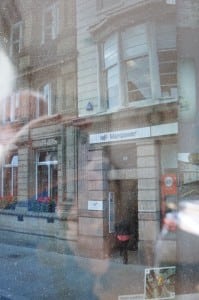
Castle Street. Edward Dickson’s pub would have stood have stood here on this prime spot before redevelopment in Liverpool city centre.
1861: Census: 55 Cairo Street, Everton. Household Edward Dickson, Publican, 61; Ellen Dickson, 50; Edward Dickson, 17, Apprentice; Alice Dickson, 13, Scholar; John Dickson, 10, Scholar; Mary Kelly, Visitor, 23, b Buxton?; Sarah Kelly, 18, Barmaid; Amelia Seville, 15, Servant of All Work.
Again, this is probably a pub as occupants include a barmaid. The street was rebuilt, probably in 1920s. No pub in it (2013). Researching.
1865: Marriage at 18 to Thomas Goode, 20 January. On marriage certificate he is described as Governor of the Workhouse, Everton, West Derby. His father is given as Thomas Saunders, Clergyman. Her father is Edward Dickson, Gentleman. Witnesses Edward Dickson and Agnes Linsey ? Ogilvie. Edward Dickson is a Publican. He is probably describing himself as a Gentleman as an aspiration. Is Thomas Goode being totally frank as well? These were hard times when people were struggling to acquire status.
Alice Ann becomes Workhouse Matron. For a girl in her teens, dealing with 1,000 impoverished inmates, many old and demented, this must have been a daunting task. Her sole qualification was being the Master’s Wife. It is difficult to imagine how she coped, especially as she then proceeded to give birth to four children, one of which died at four. The stress must have been enormous.
1868: Mother to son Albert Edward Goode.
1871: Census: West Derby Union Workhouse, Walton, Liverpool. ‘Return of all the persons who slept of abode in this institution on the night of Sunday April 2nd, 1871.’ Thomas Goode, Head of family, 33, Workhouse Master, b Wolfhamcote, Warwick; Alice Ann Goode, Wife, 24, Workhouse Matron, b Liverpool; Albert Edward Goode, Son, 3, b Walton on the Hill. Then follows a list of Workhouse staff – clerks, assistants, two school teachers, a cleaner, a book keeper, midwife, laundress, washerwoman and others.
1871: Mother to daughter Alice Ann Goode. 1871: Baptism record from parish church of St Peter, Liverpool: Alice Ann Goode born 28 April. Baptised 18 May, daughter of Thomas and Alice Ann Goode. He is described as Master of the Workhouse, Walton on the Hill.

1871: Alice Ann’s baptism. Her father Thomas describes himself as Master of the Workhouse, Walton on the Hill.
1871: Death of son Albert Edward, age 4, West Derby. Is this one of the reasons the family later left the Workhouse where infectious diseases were endemic. The whole family, especially the children, must have been at constant risk both in the institution and that part of poverty-stricken Liverpool.
1873: Mother to George A. Goode. Note: Thomas Goode still listed as ‘Master of the Workhouse, Walton’, at George’s baptism, 31 December.
1874: Mother to Ada Florence Goode, also born at West Derby (West Derby is in the title of the Workhouse).
The next record is the1881 Census, showing the change in circumstances. If accurate, the family moves from the workhouse to a pub. All family names and ages match precisely. Working in a Workhouse, even as the Master, must have been a tough, unpleasant job, especially after the death of their son Albert Edward in 1871. They would have been afraid of losing their two remaining small children, George and Ada.
Surrounded by poverty, misery and the dying, they probably wanted to escape to a more congenial life, one on a more human scale and better suited to raising a family. At this time Alice Ann Goode, Thomas’s wife, was still only around age 30. A lifetime as Workhouse Matron – a grim task in even the best circumstances – could not have been an inspiring prospect to a young mother.
In geneology research terms, the problem is the Marriage Certificate 1865 in which Thomas Goode gives his father as ‘Thomas Saunders, Clergyman’. Have found no trace of such a cleric. But this still does not explain why he is called ‘Goode’, anymore than the 1841 Census does when he is part of the ‘White’ household. All the other facts match, especially the two younger children George A. and Ada F. At George’s Baptism 1873, Thomas calls himself ‘Master of the Workhouse’. Then, in 1891 Census, Ada F. is found to be living in Cheltenham with her sister Alice Ann who is shortly to give birth to May (May Minchin to be).
Also Thomas’s switch to being a publican is more understandable in the light of having a father in law Edward Dickson, who had run two pubs, first in Castle Street, then in Cairo Street, both in Everton. It meant he had someone to guide him in his new chosen trade.
1881: Census: Kings Arms, 8 Moor Street, Ormskirk, Lancashire. Household: Thomas Goode, Head, 43, Hotel Keeper, born Wolfhamcote, Warwickshire; Alice A, 33, wife of Hotel Keeper, born Liverpool; George A, son, 8, scholar, born Walton on the Hill; Ada F, daughter, 6, scholar, born Walton on the Hill; James A Byrnes, servant, 18, billiard marker; Alice Winrow, 17, General Serv, Domestic; Mary Corfield, 20, General Servant; Ellen Mayer, 26, Servant/Barmaid.
But where is the eldest child, Alice Ann (future mother of May Minchin)?
1881: Census: Alice Ann is living with grandmother in Wolfhamcote, Warwickshire, the village where her father was born. The household for No 36 (illegible) is: Lucy White, 65, Head, b Flecknoe, Warwickshire; Alice Ann Goode, 10, granddaughter (of Lucy White), scholar, b Walton, Liverpool. But despite the Census, a doubt remains over whether Alice Ann is the biological granddaughter because a) surnames differ b) Thomas’s claim on marriage certificate that his father was a cleric called Thomas Saunders.
1881: Census. By this time the Master of Walton Workhouse is named at William Henry Bucknell, with his wife Emily as matron, confirmy Thomas Goode’s departure from the post.
1881-89: Alice Ann Goode probably died. Still researching.
Thomas Goode and his daughter Alice Ann move to Cheltenham. He meets Frances Turner, b 1842, and they marry.
Alice Ann meets Edward Wood, a pawnbroker, with a shop at 199 High Street, Cheltenham.
1889: Alice Ann Goode marries Edward Wood, Cheltenham.
1891: Census: Sherbourne Arms, a pub at 33 Sherbourne St, Cheltenham. Household: Thomas Goode, Head, 54, Licensed Victualler, b Wolfhampcote, Warwick; Frances A Goode, Wife, 49, b Leicester; Edward H Turner, Stepson (to Thomas Goode), Storekeeper/Clerk, 17; Annie Godsell, Domestic Servant, 17.
In 2013 the address is a boarded up pub, which dates back to the 1830s. Age, birthplace, profession all fit.
________________________________________________________________
Alice Ann Goode 1871-
Daughter of Thomas and Alice Goode, Mother of May Minchin
1871: Birth, 28 April. Baptism record from parish church of St Peter, Liverpool: Alice Ann Goode born 28 April. Baptised 18 May, daughter of Thomas and Alice Ann Goode. He is described as Master of the Workhouse, Walton on the Hill.
1881: Census: Living with grandmother in Wolfhamcote, Warwickshire, the village where her father was born. The household for No 36 (illegible) is: Lucy White, 65, Head, b Flecknoe, Warwickshire; Alice Ann Goode, 10, granddaughter (of Lucy White), scholar, b Walton, Liverpool.
1881-89: Her mother dies (to be confirmed). She moves to Cheltenham with her father Thomas Goode who takes over the Sherborne Arms, Cheltenham, having previously been at the Kings Arms, Ormskirk, Liverpool.
Alice Ann meets Edward Wood, who runs a pawnbroker’s shop at 199 High Street five minutes walk away.
1889: Marriage, October, to Edward Wood, Cheltenham. He had been married before and has a daughter, Nancy.
1891: Mother to William T Wood.
1891: Census: 18 Christ Church Villas, Cheltenham. Household: Edward Wood, 37, Pawnbroker, b Cheltenham; Alice A Wood, 20, b abt 1871, Walton on the Hill, Lancashire. Wife.; Elizabeth A Wood, 16, scholar; William T Wood, 2 months; Ada F Goode, Visitor, 16, Confectioners Assistant, b Walton on the Hill; Elizabeth A Taylor, 14, Domestic; Annie A Kirkham, 6, scholar. Ada F Goode is Alice’s sister, b 1874. See above.
Annie Kirkham, 6, is the daughter of John Kirkham, the grocer at 198 High Street, next to Edward’s pawnbroker shop. By 1901 Census, she is back with her father.
1893: Mother to daughter May Wood, born on 1 May, and names after the month.
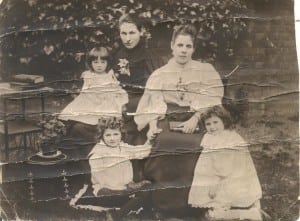

May Wood sits on the knee of her Aunt Ada (probably) alongside her mother Alice. At the front are her brother Will and step-sister Nancy.
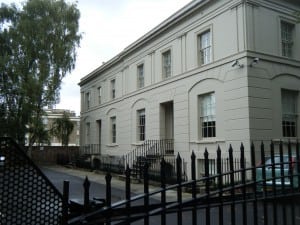

By the early 1890s, Alice and family were living at Oriel Villas, one of Cheltenham’s finest addresses, before her husband Edward encountered ‘pecuniary difficulties’.


May Wood. On the reverse, it says: ‘For Miss Hyde. From Mr and Mrs Wood. Taken when three years and a half old.’ The studio is Greenway Bros. at 339 High St, Cheltenham, just down the road from Edward Wood’s shop at no 199. Around Christmas 1894, which explains why May is buried beneath layers of clothes and fur, as well as wearing good leather boots. Here she looks a beautifully dressed middle-class child, before disaster overtook the family. The photo would have been taken in monochrome, then skilfully coloured by hand. Again May is unsmiling but that was normal in photos at the time.
1901: Queen Victoria dies, January. Thomas Goode was born one year after she acceeded to the throne and his family’s life mirrored the momentous social changes which occurred during the Victorian era. In Cheltenham, the Cheltenham Philharmonic Society marked her death with a special performance of Mozart’s Requiem.
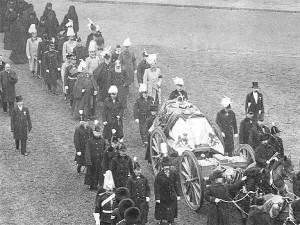

Queen Victoria’s funeral. She died on 22 January 1901 and a special performance was held by the Cheltenham Philharmonic.
1901: Census: 199 High Street. Household: Edward Wood, 47, Pawnbroker ‘own account’, b Oswestry, Shropshire.; Alice A Wood, 32; William T Wood, 10; May Wood, 8; Thomas Cartwright, 63, Servant/Pawnbrokers Assistant, b Bicester.
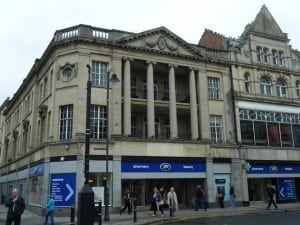

1901: Faced with pecuniary difficulties, the family are living above the pawn shop in the High Street – it is now Boots the Chemist. Desperate, Edward Wood spirals into depression and tragedy.
By this time Edward Wood is in ‘pecuniary difficulties’. One can get an impression of neighbours in the High Street. Next door, for example, is occupied by Susannah Young, who describes herself as Innkeeper Workhouse Own Account. Next there is a pork butcher, William Coates, then another pawnbroker, William Steppings, who doubles up as a hairdresser; then Tom Tickings, a beer retailer.
1901.
1902: Death of Alice Ann’s husband Edward Wood, January. Suicide, age 47, in Cheltenham.
He suffered bouts of severe depression for which he underwent treatment but it was unsuccessful. He died in Cheltenham on 4 February 1902. Apart from the grief, the impact on his family was severe at a time of limited welfare. The National Probate Calendar 1902 states: ‘WOOD Edward of 199 High-street Cheltenham died 4 February 1902 Administration (Limited) Gloucester 20 June to Mary Ann Wood spinster Effects £1117 14s. 8d.’
Mary Ann Wood is his sister, age 58, unmarried and living in Cheltenham. Despite being a businessman, he seems to have died without leaving a will. If so, he must have known the repercussions would be disastrous. It was easy in those days even for a middle-class family to lose its mark of ‘respectability’ and slip down the social scale. Life descended into a desperate struggle. Alice found it hard to cope with the remaining two children in her care, William, then eleven, and nine-year-old May (Ted, six, and step-daughter Nancy were already absent).A difficult period followed.
FOR MORE ON ALICE ANN WOOD and repercussions, SEE THIS SITE: May Wood and Bill Minchin: Drama of the Early Years.
________________________________________________________________

